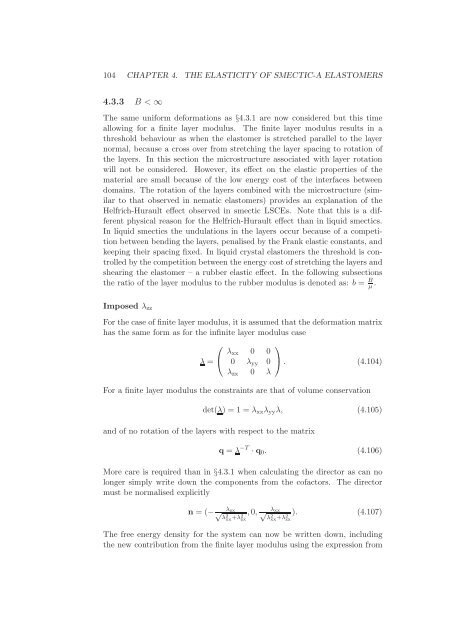Statistical models of elasticity in main chain and smectic liquid ...
Statistical models of elasticity in main chain and smectic liquid ...
Statistical models of elasticity in main chain and smectic liquid ...
Create successful ePaper yourself
Turn your PDF publications into a flip-book with our unique Google optimized e-Paper software.
104 CHAPTER 4. THE ELASTICITY OF SMECTIC-A ELASTOMERS4.3.3 B < ∞The same uniform deformations as §4.3.1 are now considered but this timeallow<strong>in</strong>g for a f<strong>in</strong>ite layer modulus. The f<strong>in</strong>ite layer modulus results <strong>in</strong> athreshold behaviour as when the elastomer is stretched parallel to the layernormal, because a cross over from stretch<strong>in</strong>g the layer spac<strong>in</strong>g to rotation <strong>of</strong>the layers. In this section the microstructure associated with layer rotationwill not be considered. However, its effect on the elastic properties <strong>of</strong> thematerial are small because <strong>of</strong> the low energy cost <strong>of</strong> the <strong>in</strong>terfaces betweendoma<strong>in</strong>s. The rotation <strong>of</strong> the layers comb<strong>in</strong>ed with the microstructure (similarto that observed <strong>in</strong> nematic elastomers) provides an explanation <strong>of</strong> theHelfrich-Hurault effect observed <strong>in</strong> <strong>smectic</strong> LSCEs. Note that this is a differentphysical reason for the Helfrich-Hurault effect than <strong>in</strong> <strong>liquid</strong> <strong>smectic</strong>s.In <strong>liquid</strong> <strong>smectic</strong>s the undulations <strong>in</strong> the layers occur because <strong>of</strong> a competitionbetween bend<strong>in</strong>g the layers, penalised by the Frank elastic constants, <strong>and</strong>keep<strong>in</strong>g their spac<strong>in</strong>g fixed. In <strong>liquid</strong> crystal elastomers the threshold is controlledby the competition between the energy cost <strong>of</strong> stretch<strong>in</strong>g the layers <strong>and</strong>shear<strong>in</strong>g the elastomer – a rubber elastic effect. In the follow<strong>in</strong>g subsectionsthe ratio <strong>of</strong> the layer modulus to the rubber modulus is denoted as: b = B µ .Imposed λ zzFor the case <strong>of</strong> f<strong>in</strong>ite layer modulus, it is assumed that the deformation matrixhas the same form as for the <strong>in</strong>f<strong>in</strong>ite layer modulus case⎛ ⎞λ xx 0 0λ = ⎝ 0 λ yy 0 ⎠. (4.104)λ zx 0 λFor a f<strong>in</strong>ite layer modulus the constra<strong>in</strong>ts are that <strong>of</strong> volume conservationdet(λ) = 1 = λ xx λ yy λ, (4.105)<strong>and</strong> <strong>of</strong> no rotation <strong>of</strong> the layers with respect to the matrixq = λ −T ·q 0 . (4.106)More care is required than <strong>in</strong> §4.3.1 when calculat<strong>in</strong>g the director as can nolonger simply write down the components from the c<strong>of</strong>actors. The directormust be normalised explicitlyn = (−√ λzx ,0, √λ xx(4.107)λ 2 xx +λ 2 zx λ 2 xx +λzx). 2The free energy density for the system can now be written down, <strong>in</strong>clud<strong>in</strong>gthe new contribution from the f<strong>in</strong>ite layer modulus us<strong>in</strong>g the expression from
















